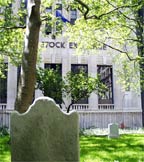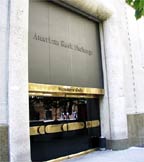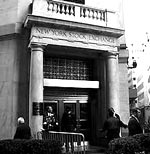-
It has a lower volume of trading.
It has lower-status company listings.
It was forced to merge with the Nasdaq to survive.
Too much yin.
 |
|
| Chi-bang: Dark, reflective doors bounce positive chi back. | |
| Photo credit: Ellen Leventry |
Like the bull and the bear of the market, chi is composed of opposing forces -- yang and yin. Yang energy is light, high, bright and active, while yin energy is dark, low and inactive. An excess of yin translates into not enough energy for life -- which means not enough energy for business, says Roberts, who does residential and corporate consulting. Feng shui practitioners attempt to balance the opposing forces through the auspicious placement of buildings, doors, furniture and other objects in order to create harmony, prosperity and well-being.
Once solely a New Age preoccupation, feng shui has lured such soulful '90s converts as Donald Trump and Oprah Winfrey. The Donald consulted a feng shui specialist before building his hulking Trump International Hotel in New York -- hence the blinding silver globe out front at Columbus Circle. And Oprah is purported to have worked out her chi issues with a consultant. Even Wall Street has taken stock of its chi flow.
Salomon Smith Barney is reported to have employed the services of feng shui specialists, and Credit Lyonnaise Securities Asia puts out a yearly feng shui index for the Chinese New Year.
 |
|
| Cemeteries and commerce, like oil and water. | |
| Photo credit: Ellen Leventry |
Unfortunately for the American Stock Exchange, it's got huge feng shui
issues, says Roberts. For starters, it's downhill from the Trinity
Church cemetery. A graveyard is as yin as they come -- it doesn't get
any more inactive, folks. Then there's the exchange's downsized entryway
that limits the amount of chi entering. The doors made of dark glass
actually deflect what little free-flowing chi there is, and its flat facade
fails to grab the attention and energy of passers-by. Put simply, the Amex
is long on yin, short on yang.
This isn't keeping anyone up nights, it seems. When asked if he had an opinion on the excess yin, Amex spokesperson Steve Pechdimaldji managed to hold back his laughter just long enough to say, "Absolutely none."
After taking a look at that other exchange, however, he might change his mind.
The Big Board could easily be dubbed the New Yang Stock Exchange. Surrounded by money -- literally, most of the buildings around it are banks -- the architecture of the NYSE exudes prosperity. One of the most distinctive features, the soaring columns in front, are a particularly good sign, says Roberts. They represent wood energy, the principle of beginnings
and new life. "Think of growth -- that's what you want from the stock market." (Even in feng shui, the value investors can't win.)
 |
|
| The hulking Bank of New York building provides a sturdy backrest for the NYSE. | |
| Photo credit: Ellen Leventry |
Then there's what Roberts calls the armchair analogy. Businesses prosper best in an "armchair" -- a location tucked among a substantially taller building to the rear and slightly taller buildings to either side, with an open area in front. This formation supports, comforts and protects. With the monolithic Bank of New York Building as a backdrop and the exchange tower and another Bank of New York building on either side, the NYSE sits snugly in a canyon of capitalism.
Ironically enough, the barriers that whittle the street in front of the NYSE down to one lane, keeping car bombs at arm's length, create a perfect plaza for lots of people and positive, lively chi to gather. (For
its part, the NYSE says it prefers not to comment.)The Amex, meanwhile, lounges in something akin to a bean-bag chair. While the Pussycat Lounge and Tijuana Tom's on the street behind the exchange may do much to prop up the, uh, spirits of the trading community, they unfortunately do nothing to support the Amex's exposed backside. Flanked by buildings of varying size, it faces the cemetery's elevated retaining wall. "You get the feeling that you can't even move forward," says Roberts. The slice of sidewalk in front of the exchange that's aptly nicknamed "The Curb" attracts only a few traders, out for smoke breaks.
 |
|
| Coming and going: Angled doorways snatch chi coming from both directions. | |
| Photo credit: Michael Podrazik |
Flying a snazzy flag and adding more flags in general would stir stagnant chi around, Roberts says. But to truly energize the exchange, she suggests a rather pedestrian fix: infusing it with real, lifelike school groups and gaggles of tourists.
Ultimately, feng shui is about making informed choices, says Roberts. The most advantageous chi fix would be to find a new location -- a possibility that the Amex has been debating for months. But as with all things on Wall Street, "it would just depend on their budget," says Roberts. If the Amex does move, it should look for a locale that gives it more yang for its buck.

